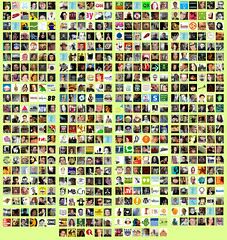I started this post back in February 2008 and left it for a while. I was never quite able to finish it — and it didn’t seem overly important. But in light of the recent problems with Twitter and the emergence of the shiny new Plurk, I thought I would resurrect this post and look again at the future, potential and challenges for services such as Twitter, Plurk, Jaiku and Pownce.
 I remember how Twitter sped into my consciousness. It was like a freight train with a big Web 2.0 emblazoned on the locomotive. Hanging out the windows of the carriages were the smiling avatars of my marketing and social media friends. All were smiling and waving, beckoning me to climb aboard. It seemed like a no-brainer … and, in fact, it was. There was very little thought process involved — I climbed aboard because all my friends were already there.
I remember how Twitter sped into my consciousness. It was like a freight train with a big Web 2.0 emblazoned on the locomotive. Hanging out the windows of the carriages were the smiling avatars of my marketing and social media friends. All were smiling and waving, beckoning me to climb aboard. It seemed like a no-brainer … and, in fact, it was. There was very little thought process involved — I climbed aboard because all my friends were already there.
As I explored Twitter, I started seeing my friends discussions. I realised that there were conversations going on that I wanted to be part of, that I at least wanted to LISTEN to. So I would begin to “follow” others. That meant that Twitter would notify them of my intention to eavesdrop or contribute to their discussions, and in effect this served as a virtual introduction. My pre-existing connection to others had opened the door for me.
This made me rethink my approach to Facebook and to LinkedIn. As you can probably see, up the top of my website is a badge that links to my LinkedIn profile. If you click it and want to add me to your network I don’t generally decline (in fact, I don’t think that I have ever). I am a little more selective about Facebook where I do feel that I need to know a little about you before “friending” you. But why? What was this all about … and how did it relate to Twitter?
Gradually I realised that the folks on Twitter were a whole lot less guarded about their discussions than they may be about their profiles on Facebook. And the same applied to me. That meant that it was completely acceptable to “follow” a stranger on Twitter — and in the process it opened up my personal social graph to a flood of chaos and random encounters. It felt a little dangerous … but at the heart of it was the clear understanding of my role as a creator of content. Twitter was providing the space and as a dutiful “one percenter”, I was filling it with the best content that I could muster in 140 characters. So were my one percenter colleagues. We had an unspoken contract with Twitter — and it was symbiotic — we soon needed each other, desperately.
Digging around in Twitter, however, it was clear that the user base was mature — or should I say “adult”. This seemed counter-intuitive to me, because I expected Twitter to be a walk up natural service for teens — and Andy Beal seemed to think the same in this interesting post. But for my money, the reason that teens have not been attracted to Twitter is fundamental. Surprisingly it is not about the COMMUNITY … it’s about the INTENTION.
Twitter has been able to build a community around its technology. It started with a tech friendly audience at SXSW and grew from there. It was successful at positioning itself as an APPLICATION. That meant that we were overtly aware of Twitter as a piece of enabling technology — we knew and understood that this would entail ups, downs, failures and disappointments. We were viewing Twitter as a technology — we were co-creating the Twitter community. As David Cushman says, “It is built for communities of purpose to form in a networked conversation-driven way, not for an audience to consume what they are creating”.
But such a position is anathema to a teenage audience. For them, the very act of connecting is, in itself, a creation of value. The resulting relationships and the experience that they engender is of intrinsic importance to a generation world-wise and weary of “markets”, “brands” and the emptiness of promises. There is little surprise then, that Twitter holds no appeal.
Plurk, however, is different from its core. The Plurk team view their mission as a service. They want to go “Beyond FUBU” — beyond the for us, by us mantra that permeates many start-ups. Now, whether this is true or not, it certainly appeals to Generation Y. And it seems to be something that is also tweaking the ears of an expectant Twitter community. After the recent outage furore and poor communication all round, perhaps the adults in the Twitter community are waking up to a new level of expectation and maturity — technology as service. And this may be the very reason that Plurk (or its successor) wins out long term. It is not about the technology or even the utility. It’s about the service and the experience — something the kids got long ago.



